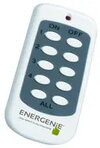I have Mitsubishi PLC's getting on a bit now, I think FX2N series, with a HMI to work with them. Since already have them, I did consider using them, but if they fail then no longer made, and also the programming software and lead uses the old serial port not USB, so would need to program with old desk top.
Where I live we have no commercial radio reception so we use Google Nest Mini's to listen to radio, these allow us to also use voice commands, I started with Energenie smart controls with my late mother as a way to control extruder alarm so we could answer door without running upstairs to turn it off, but they would auto reset, basic combining a time clock and remote switching in one device, and we also used the TRV heads, which were a little OTT with the anti hysteresis but other wise worked well. And also some light switches as did not have two way switching, so in the main using the remote control

I did have the hub to program the TRV's but once programmed not required, so there was no need for internet for it to work.
Since then I have added more, and google home has allowed me to integrate different makes, but my TP-Link light switches for example will work as standard light switches without any hub or router or internet, so the worry about loss of internet is not really valid.
There was once a problem due to loss of the mobile phone mast in high winds, but to be frank the problem was I had not realised what had happened, I had the Nest Gen 3 set for geofencing, so loss of mast resulted in it thinking I was not home, and because Nest also have a PIR built into the thermostat, it would switch to comfort each time I approached then after a set time back to Eco setting. Once I realised the problem turning the geofencing off was easy.
I do not walk around the house with a mobile phone glued to my ear, so using the phone to control the house is rather inconvenient. So I need some other method like the remote shown to control the smart devices, and each make seems to have a different method. Used a magnetic button

but quickly realised with voice control it was simply not used, so reused it as a door bell, which has some advantages as I can see when it was used. Not gone full video door bell as yet. The use of voice control with Google Nest Mini's means I do have control with the google Home app on the phone, so all the different makes all work with one app.
The problem has been the smart bulbs, each make has different options. Dusk and dawn and fad off as an example. In the main lighting work better with smart bulbs, no standard dimming switch can adjust the colour temperature of the bulb, where with a smart bulb one can even select colour, the down side is they cost around £10 each, so with an 8 bulb chandelier it starts to get expensive. Hate to think what it would cost with silly GU10 down lights, but it could make rather a good planetarium setting them out as the great bear would be a talking point.
But with the standard smart devices, if I am ill, most electricians could repair what I have, and I can select my lights to auto switch on at dusk or off at dawn, which is about the only function which would stop with internet failure, as time would not update. Other than geofencing of course. And not sure if worth having geofencing?
The big advantage is when I arrive home at night, I can use my mobile to turn on all outside lights, no PIR switching off at the most inappropriate moment when on the steps with hands full of shopping.



